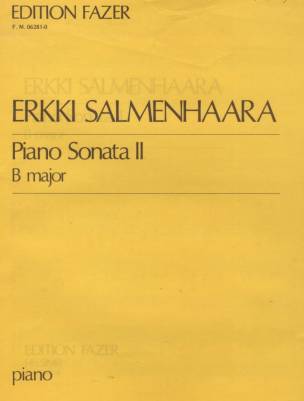Piano Sonata II B major — Piano
Salmenhaara, ErkkiProduct information
| Title: | Piano Sonata II B major — Piano | ||
| Authors: | Salmenhaara, Erkki (Composer) | ||
| Product number: | 9790042062814 | ||
| Product form: | Sheet music | ||
| Availability: | Delivery in 7-16 days | ||
| Price per piece: | 19,69 € (17,27 € vat 0 %) | ||
|
|||
| Publisher: | Fennica Gehrman |
| Edition: | |
| Language: | undefined |
| Product family: | Piano |
| Finnish library classification: | 78.61 Piano |
| Key words: | pianosonaatit |
Mesmerizing repeated figures and rich modal sound world are typical features and present in Erkki Salmenhaara's luminous Piano Sonata II (1973).
Movements:
I Andante
II Allegro assai
III Andante
IV Allegro
Having joined the emergent avant-garde movement in the early 1960s, Erkki Salmenhaara (1941-2002) proceeded via experimentalism and web technique to a tonal motif technique. His move towards web technique is most pronounced in Elegia II (1963), in which the entire texture is determined according to its breadth, harmonic and rhythmic density, dynamics and timbre. A stylistic turning-point came with Le bateau ivre (1965, revised 1966), inspired by Rimbaud. Its timbres, now associated more with the mixtures of Impressionism, are melodically and harmonically constructed from triads. Later in the 1970s Salmenhaara's music became more concentrated and tonality became so established that key signatures reappeare.
Movements:
I Andante
II Allegro assai
III Andante
IV Allegro
Having joined the emergent avant-garde movement in the early 1960s, Erkki Salmenhaara (1941-2002) proceeded via experimentalism and web technique to a tonal motif technique. His move towards web technique is most pronounced in Elegia II (1963), in which the entire texture is determined according to its breadth, harmonic and rhythmic density, dynamics and timbre. A stylistic turning-point came with Le bateau ivre (1965, revised 1966), inspired by Rimbaud. Its timbres, now associated more with the mixtures of Impressionism, are melodically and harmonically constructed from triads. Later in the 1970s Salmenhaara's music became more concentrated and tonality became so established that key signatures reappeare.








